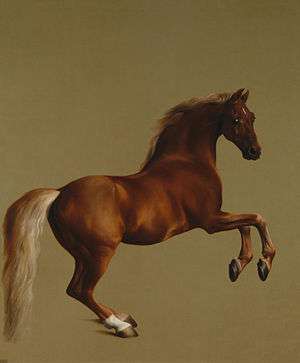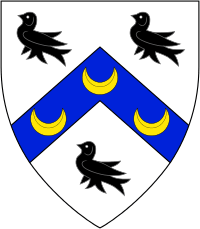Wentworth Woodhouse
- A similarly named country house in Yorkshire is Wentworth Castle.
| Wentworth Woodhouse | |
|---|---|
|
East front of Wentworth Woodhouse | |
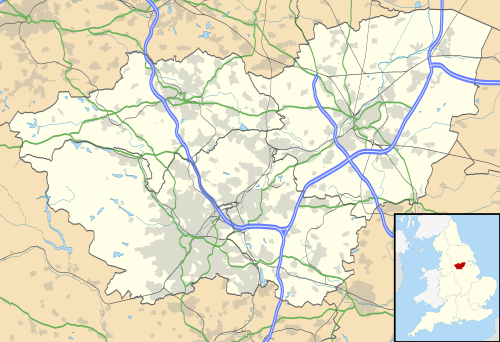 Location within South Yorkshire | |
| General information | |
| Status | Under construction |
| Type | Stately home |
| Architectural style |
West front English Baroque East front Palladian |
| Location | Wentworth, South Yorkshire |
| Country | England |
| Coordinates | 53°28′27″N 1°24′17″W / 53.47417°N 1.40472°W |
| Owner | Wentworth Woodhouse Preservation Trust |
| Design and construction | |
| Architect |
William Etty Ralph Tunnicliffe Henry Flitcroft John Carr |
| Other information | |
| Parking | No |
| Website | |
|
www | |

Wentworth Woodhouse is a Grade I listed country house in the village of Wentworth, near Rotherham in South Yorkshire, England. It is the largest private house in the United Kingdom[1][2] and, with an east front of 606 feet (185 m), has the longest country house façade in Europe.[3][4][5] The house has more than 300 rooms, although the precise number is unclear, with 250,000 square feet (23,000 m2) of floorspace[2] (124,600 square feet (11,580 m2) of living area). It covers an area of more than 2.5 acres (1.0 ha), and is surrounded by a 180-acre (73 ha) park, and an estate of 15,000 acres (6,100 ha).
The original Jacobean house was rebuilt by Thomas Watson-Wentworth, 1st Marquess of Rockingham (1693–1750), and vastly expanded by his son, the 2nd Marquess, who was twice Prime Minister, and who established Wentworth Woodhouse as a Whig centre of influence.[6] In the 18th century, the house was inherited by the Earls Fitzwilliam who owned it until 1979, when it passed to the heirs of the 8th and 10th Earls, its value having appreciated from the large quantities of coal discovered on the estate.[7]
Architecture

Wentworth Woodhouse comprises two joined houses, forming west and east fronts. The original house, now the west front, with the garden range facing northwest towards the village, was built of brick with stone details. The east front of unsurpassed length is credibly said to have been built[8] as the result of a rivalry with the Stainborough branch of the Wentworth family, which inherited the Great Strafford's minor title of Baron Raby, but not his estates, which went to Watson, including the notable series of Strafford portraits by Anthony van Dyck and Daniel Mytens, who added Wentworth to his surname. The Stainborough Wentworths, for whom the Strafford earldom was revived, lived at nearby Wentworth Castle, which was purchased in 1708, in a competitive spirit, and strenuously rebuilt in a magnificent manner.
History
The English Baroque, brick-built, western range of Wentworth Woodhouse was begun in 1725 by Thomas Watson-Wentworth, (after 1728 Lord Malton)[9] after he inherited it from his father in 1723. It replaced the Jacobean structure that was once the home of Thomas Wentworth, 1st Earl of Strafford, whom Charles I sacrificed in 1641 to appease Parliament. The builder to whom Wentworth's grandson turned for a plan for the grand scheme that he intended,[10] was a local builder and country architect, Ralph Tunnicliffe,[11] who had a practice in Derbyshire and South Yorkshire. Tunnicliffe was pleased enough with this culmination of his provincial practice to issue an engraving signed "R. Tunniclif, architectus"[12] which must date before 1734, as it is dedicated to Baron Malton, Watson-Wentworth's earlier title.[12] However the Baroque style was disliked by Whigs, and the new house was not admired. In c. 1734, before the West Front was finished, Wentworth's grandson Thomas Watson-Wentworth commissioned Henry Flitcroft to build the East Front "extension", in fact a new and much larger house, facing the other way, southeastward. The model they settled on was Colen Campbell's Wanstead House, illustrated in Vitruvius Britannicus i, 1715.
That same year the rebuilding was already well underway. In a letter from the amateur architect Sir Thomas Robinson of Rokeby to his father-in-law Lord Carlisle of 6 June 1734, Sir Thomas reports that he found the garden front "finished" and that a start had been made on the main front: "when finished 'twill be a stupendous fabric, infinitely superior to anything we have now in England," and he adds "The whole finishing will be entirely submitted to Lord Burlington, and I know of no subject's house in Europe will have 7 such magnificent rooms so finely proportioned as these will be."[13] In the 20th century, Nikolaus Pevsner would agree,[14] but the mention of the architect-earl Burlington, arbiter of architectural taste, boded ill for the provincial surveyor-builder, Tunnicliffe. It is doubtless to Burlington's intervention that about this time, before the West Front was finished, the Earl of Malton, as he had now become, commissioned Henry Flitcroft to revise Tunnicliffe's plan there and build the East Front range. Flitcroft was Burlington's professional architectural amanuensis— "Burlington Harry" as he was called; he had prepared for the engravers the designs of Inigo Jones published by Burlington and William Kent in 1727, and in fact Kent was also called in for confabulation over Wentworth Woodhouse, mediated by Sir Thomas Robinson,[15] though in the event the pedestrian Flitcroft was not unseated and continued to provide designs for the house over the following decade: he revised and enlarged Tunnicliffe's provincial Baroque West Front and added wings, as well as temples and other structures in the park. Contemporary engravings of the grand public East Front give Flitcroft as architect. Flitcroft, right-hand man of the architectural dilettanti and fully occupied as well at the Royal Board of Works, could not constantly be on-site, however: Francis Bickerton, surveyor and builder of York, paid bills in 1738 and 1743.
The grand East Front is the more often illustrated. The West front, the "garden front" that Sir Thomas Robinson found to be finished in 1734, is the private front that looked onto a giardino secreto between the house front and the walled kitchen garden, intended for family enjoyment rather than social and political ambitions expressed in the East Front.[16] Most remnants of it were redesigned in the 19th century.[17]

Wentworth Woodhouse was inherited by Charles Watson-Wentworth, 2nd Marquess of Rockingham, briefly Prime Minister in 1765–66 and again in 1782. He received Benjamin Franklin here in 1771. The architect he employed at the house was John Carr of York, who added an extra storey to parts of the East Front and provided the porticoes to the matching wings, each the equivalent of a moderately grand country house. James "Athenian" Stuart contributed designs for panels in the Pillared Hall.[18] The Whistlejacket Room was named for George Stubbs' portrait that hung in it of Whistlejacket, one of the most famous racehorses of all time.[19] The additions were completed in 1772. The second Marquess envisaged a sculpture gallery at the house, which never came to fruition; four marbles by Joseph Nollekens were carried out to his commission, in expectation of the gallery; the Diana, signed and dated 1778, is now at the Victoria and Albert Museum, the Juno, Venus and Minerva, grouped with a Roman antique marble of Paris, are at the J. Paul Getty Museum.[20]
Wentworth Woodhouse, with all its contents, subsequently passed to the family of the Marquess's sister, the Earls Fitzwilliam.
The park
Having finished the course of alterations in the hands of John Carr, Lord Fitzwilliam turned in 1790 to the most prominent landscape gardener,[21] Humphry Repton, for whom this was the season's most ambitious project, one that he would describe in detail while the memory was still fresh, in Some Observations of the Theory and Practice of Landscape Gardening (1803). A terrace centred on the main block effected a transition between the house and the rolling grazing land. Four obelisks stood on the bowling green, dwarfed by the scale of the house;[22] Repton re-sited them. Though the parkland had accumulated numerous eye-catcheres and features (see below), Repton found there were few trees, the house being surrounded by "coarse grass and boulders"[23] which Repton also removed, before the large-scale earth-moving operations began, effected by men with shovels and donkey-carts, to reshape the lumpy ground into smooth swells. Two large pools, visible from the East Front and the approach drive, were excavated into a serpentine shape. Some of Flitcroft's outbuildings were demolished, though not Carr's handsome stable court (1768), entered through a pedimented Tuscan arch. Many trees were planted.
Follies
The grounds (and surrounding area) contain a number of follies, many with associations in the arena of 18th-century Whig politics. They include:
- Hoober stand. A tapering pyramid with a hexagonal lantern, named for the ancient wood in which it was erected. It is 98 feet (30 m) high and was built to Flitcroft's design in 1747–48 to commemorate the defeat of the Jacobite rebellion, in which Lord Malton and his surviving son took part; his defensive efforts for the Hanoverian Whig establishment were rewarded with the Lord Lieutenancy of Yorkshire and the title Marquess of Rockingham: thus the monument indirectly reflects the greater glory of the family. The tower, which surveys the surrounding landscape like a watchtower, is open to the public on Sunday afternoons throughout the summer.
- Keppel's Column. A 115 ft (35 m) Tuscan column built to commemorate the acquittal of the court-martialed Admiral Keppel, a close friend of Rockingham. Its entasis visibly bulges, due to an adjustment in its height, made when funding problems reduced the height. It was designed by John Carr.
- The Rockingham Mausoleum. A three-storey building 90 ft (27 m) high, situated in woodland, where only the top level is visible over the treetops. It was commissioned in 1783 by the Earl Fitzwilliam as a memorial to the late first Marquess of Rockingham; it was designed by John Carr, whose first design, for an obelisk, was rejected, in favour of an adaptation of the Roman Cenotaph of the Julii at Saint-Rémy-de-Provence, near Arles.[24] The ground floor is an enclosed hall containing a statue of the former prime minister by Joseph Nollekens, plus busts of his eight closest friends. The first floor is an open colonnade with Corinthian columns surrounding the (empty) sarcophagus. The top storey is a Roman-style cupola. Like Hoober Stand, the Mausoleum is open on summer Sunday afternoons.
- Needle's Eye. A 46-foot (14 m) high, sandstone block pyramid with an ornamental urn on the top and a tall Gothic ogee arch through the middle, which straddles a disused roadway. It was built in the 18th century allegedly to win a bet after the second Marquess claimed he could drive a coach and horses through the eye of a needle.
- Bear Pit. Accessible if patronising the nearby Garden centre. Built on two levels with a spiral stair. The outer doorway (about 1630) is part of the architecture of the original house. At the end of the garden is a grotto guarded by two life-sized statues of Roman soldiers.
 "Doric Lodge" in the grounds
"Doric Lodge" in the grounds The Needle's Eye
The Needle's Eye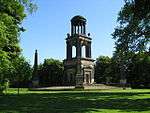 The Rockingham Mausoleum
The Rockingham Mausoleum Doorway to the Bear Pit
Doorway to the Bear Pit
Royal visit of 1912
King George V and Queen Mary visited South Yorkshire from 8 to 12 July 1912, and stayed at Wentworth Woodhouse for four days. The house party consisted of a large number of guests, including: Dr Cosmo Gordon Lang, Archbishop of Canterbury; The 5th Earl of Harewood and The Countess of Harewood; The Marchioness of Londonderry; The 1st Marquess of Zetland and Lady Zetland; The 10th Earl of Scarborough and Lady Scarborough; The 5th Earl of Rosse and Lady Rosse; Admiral Lord Charles Beresford and Lady Mina Beresford; Mr Walter Long and Lady Doreen Long; and Lord Helmsley and Lady Helmsley.[25]
The visit concluded on the evening of 11 July with a torchlight tattoo by miners, and a musical programme by members of the Sheffield Musical Union and the Wentworth Choral Society. A crowd of 25,000 gathered on the lawn to witness the King and Queen in the balcony of the portico, from which the King gave a speech.[26]
Destruction of the estate
In April 1946, on the orders of Manny Shinwell (the then Labour Party's Minister of Fuel and Power) a "column of lorries and heavy plant machinery" arrived at Wentworth. The objective was the mining of a large part of the estate close to the house for coal. This was an area where the prolific Barnsley seam was within 100 feet (30 m) of the surface and the area between the house and the Rockingham Mausoleum became the largest open cast mining site in Britain at that time: 132,000 tons of coal were removed solely from the gardens.[27] Ostensibly the coal was desperately needed in Britain's austere post-war economy to fuel the railways, but the decision has been, and is, widely seen as useful cover for an act of class-war spite against the coal-owning aristocracy. A survey by Sheffield University, commissioned by Peter Wentworth-Fitzwilliam, the 8th Earl, found the quality of the coal as "very poor stuff" and "not worth the getting"; this contrasted to Shinwell's assertion that it was "exceptionally good-quality."[28]
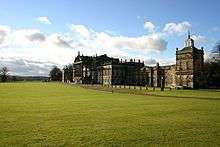
Shinwell, intent on the destruction of the Fitzwilliams and "the privileged rich", decreed that the mining would continue to the back door of Wentworth, the family's East Front. What followed saw the mining of 99 acres (400,000 m2) of lawns and woods, the renowned formal gardens and the show-piece pink shale driveway (a by-product of the family's collieries). Ancient trees were uprooted and the debris of earth and rubble was piled 50 ft (15 m) high in front of the family's living quarters.[28]
Local opinion supported the Earl. Joe Hall, Yorkshire branch President of the National Union of Mineworkers, said that the "miners in this area will go to almost any length rather than see Wentworth Woodhouse destroyed. To many mining communities it is sacred ground" – in an industry known for harsh treatment of workers, the Fitzwilliams were respected employers known for treating their employees well. The Yorkshire branch later threatened a strike over the Government's plans for Wentworth, and Joe Hall wrote personally to Clement Attlee in a futile attempt to stop the mining.[28] This spontaneous local activism, founded on the genuine popularity of the Fitzwilliam family amongst locals, was dismissed in Whitehall as "intrigue" sponsored by the Earl.[29]
The opencast mining moved into the fields to the west of the house and continued into the early 1950s. The mined areas took many years to return to a natural state; much of the woodland and the formal gardens were not replaced. The current owners of the property allege that mining operations near the house caused substantial structural damage to the building due to subsidence,[30] and lodged a claim in 2012 of £100 million for remedial works against the Coal Authority.[31]
Two sets of death duties in the 1940s, and the nationalization of their coal mines, greatly reduced the wealth of the Fitzwilliams, and most of the contents of the house were dispersed, in auction sales in 1948, 1986 and 1998. In the Christies sale in 1948, Rinaldo conquered by Love for Armida by Anthony van Dyck raised 4,600 Guineas[32] (equivalent to £158,393 in 2015).[33]
Many items still remain in the family, with many works lent to museums by the "Trustees of the Fitzwilliam Estates".
On 23 November 2016, the Conservative Chancellor Philip Hammond announced that £7.6 million would be invested into reversing the damage caused by the Labour Party decision in 1945, and restore the house to conditions suitable for visitation.[34]
Lease to Lady Mabel College
The Ministry of Health attempted to requisition the house as "housing for homeless industrial families". To prevent this, the Earl attempted to donate the house to the National Trust, however the Trust declined to take it. In the end, Lady Mabel Fitzwilliam, sister of the 7th Earl and a local alderman, brokered a deal whereby the West Riding County Council leased most of the house for an educational establishment, leaving forty rooms as a family apartment.[35] Thus, from 1949 to 1979, the house was home to the Lady Mabel College of Physical Education, which trained female physical education teachers. The college later merged with Sheffield City Polytechnic (now Sheffield Hallam University), which eventually gave up the lease in 1988 due to high maintenance costs.[36]
Sold by Fitzwilliam family
By 1989, Wentworth Woodhouse was in a poor state of repair. With the polytechnic no longer a tenant, and with the family no longer requiring the house, the family trustees decided to sell it and the 70 acres (280,000 m2) surrounding it, but retained the Wentworth Estate's 15,000 acres (61 km2) of land. The house was bought by locally born businessman Wensley Grosvenor Haydon-Baillie, who started a programme of restoration. However a business failure caused it to be repossessed by a Swiss bank and put back on the market in 1998.[37] Clifford Newbold (July 1926 – April 2015),[38] an architect from Highgate, bought it for something over £1.5 million.[39] Newbold progressed with a defined programme of renovation/restoration as evidenced in Country Life magazine dated 17 and 24 February 2010.[40] The surrounding parkland is owned by the Wentworth Estates.
In 2014, the house was informally offered for sale by Newbold, with no price specified, but a figure of around £7 million was thought to be sought according to The Times. The house was reported to need works of around £40 million.[41] Following the death of Mr. Newbold, the house was formally advertised for sale in May 2015 via Savills with an asking price of £8 million.[42] In February 2016, the house was sold to the Wentworth Woodhouse Preservation Trust for £7 million after a sale to the Hong Kong-based Lake House Group fell through.[43]
In the United Kingdom Chancellor's budget statement of November 2016, it was announced that the Trust was to receive a grant of £7.6 million for restoration work; the Chancellor noted a claim that the property had been Jane Austen's inspiration for Pemberley in her novel Pride and Prejudice.[44][45] It was thought that there might have been a connection to the house because Austen uses the name Fitzwilliam in her novel, but following the Chancellor's Autumn Statement the Jane Austen Society dismissed the likelihood that Austen had had the house in mind, given the absence of any evidence that she had visited the estate.[46][42]
Publication
The series from BBC titled The Country House Revealed was accompanied by a full-length illustrated companion book published by the BBC which featured a dedicated chapter on Wentworth Woodhouse (Chapter Four). The six chapters of the book corresponded to the six episodes of the BBC series.[47]
Film locations
The house and grounds have been used in a number of film and television productions including:
- Wives and Daughters (1999)
- The Thirteenth Tale (2013)
- Mr. Turner (2014)
- Jonathan Strange & Mr Norrell (2015)
- Victoria (TV series) (2016)
See also
- The Wodehouse, a country house near Wombourne, Staffordshire, notable for its connections with British musical history
- The Country House Revealed, Wentworth House was featured in Dan Cruickshank's show exploring houses not open to the public and the families which built them.
References
- ↑ Guinness Book of Records, 1966, p.175
- 1 2 Visiting Britain's Largest and Smallest Houses by Various Travel Authors on Creators.com – A Syndicate Of Talent
- ↑ The Sunday Times Magazine, 11 February 2007, p 19
- ↑ Wentworth Woodhouse: A vision of greatness – Yorkshire Post
- ↑ Passino, Carla. "'Pride and Prejudice' Estate Is Up for Sale". Forbes. Retrieved 11 January 2016.
- ↑ M. J. Charlesworth, "The Wentworths: Family and Political Rivalry in the English Landscape Garden" Garden History 14.2 (Autumn 1986):120–137) passim.
- ↑ The Fitzwilliam family archives from Wentworth Woodhouse were deposited at Sheffield Public Library in 1948.
- ↑ Charlesworth 1986:120–137 passim.
- ↑ Baron Malton, as he then was; he was subsequently created Earl of Malton (1734) and Marquess of Rockingham (1746).
- ↑ The first block constructed already included a ground-floor gallery 130 feet (40 m) long (Charlesworth 1986:126).
- ↑ Ralph Tunnicliffe (ca 1688–1736) appears in several churchwardens' accounts for rebuilding and alterations to churches; just before his involvement at Wentworth Woodhouse, he had been making alterations at Wortley Hall, West Yorkshire, for Edward Wortley Montagu (Howard Colvin, A Biographical Dictionary of British Architects, 1600–1840 3rd ed. [Yale University Press] 1995, s.v. "Tunnicliffe, Ralph"); Wortley Montagu was a prominent Whig politician who moved in the same circles as Lord Malton: an obelisk honouring his wife, Lady Mary Wortley Montagu stands in the rival Wentworth parkland, Wentworth Castle.
- 1 2 Colvin 1995, s.v "Tunnicliffe, Ralph".
- ↑ Quoted in Michael I. Wilson, William Kent, Architect, Designer, Painter, Gardener, 1685–1748 1984:166f.
- ↑ Pevsner, "The interiors of Wentworth Woodhouse are of a quite exceptional value... The suite along the E front from the Whistlejacket Room at the SE to the library at the NE end is not easily matched anywhere in England" (Yorkshire: The West Riding [Buildings of England] 1967:546).
- ↑ Sir Thomas Robinson in another letter to Carlisle, enclosing Kent's engraved design for the Treasury Buildings in Whitehall,"'tis some satisfaction to me, as a Yorkshireman (and as I was entrusted by Lord Malton in negotiating the agreement between him and Mr. Kent), to reflect that the architect of this beautiful building [the Treasury] is from henceforward to conduct and finish his Lordship's" (quoted in Wilson 1984:166). No intervention by Kent in Flitcroft's project at Wentworth Woodhouse has been detected by historians, however.
- ↑ "as this theatre of politics unfolded over the next half-century it was commemorated by the protagonists in stone, Charlesworth remarked (1986:129).
- ↑ Charlesworth 1986:127.
- ↑ His portraits of William III and George II, commissioned by Rockingham, have not been traced: Martin Hopkinson, "A Portrait by James 'Athenian' Stuart" The Burlington Magazine 132 No. 1052 (November 1990:794–795) p. 794.
- ↑ Dated ca 1768–70 by Ellis K. Waterhouse, "Lord Fitzwilliam's Sporting Pictures by Stubbs" The Burlington Magazine for Connoisseurs 88 No. 521 (August 1946:197, 199).
- ↑ Paul Williamson, "Acquisitions of Sculpture at the Victoria and Albert Museum, 1986–1991: Supplement" The Burlington Magazine 133 No. 1065 (December 1991:876–880) p. 879, fig. xi.
- ↑ The grander term "landscape architect" was a coinage of the late 19th century.
- ↑ Horace Walpole had thought they looked like tenpins.
- ↑ Repton 1803, quoted by Edward Hyams, Capability Brown and Humphrey Repron, 1971:148f.
- ↑ Noted by Charlesworth 1986:135.
- ↑ "Society and Court News.". Leeds Mercury. Leeds. 9 July 1912. Retrieved 1 June 2015.
- ↑ ""My Friends." The King's Speech to His Subjects. Wentworth Spectacle". Sheffield Evening Telegraph. Sheffield. 12 July 1912. Retrieved 1 June 2015.
- ↑ Hyams 1971:149.
- 1 2 3 The Sunday Times Magazine, 11 February 2007 p. 23
- ↑ Catherine Bailey, Black Diamonds: The Rise and Fall of an English Dynasty, (London: Penguin) 2007:393. ISBN 0-670-91542-4
- ↑ "Stately home owners claim £100 million as house sinks into ground". The Telegraph. 26 February 2012. Retrieved 3 March 2013.
- ↑ "£100m Claim for Owners of Wentworth Woodhouse Stately Home". Salmon Assessors Ltd. 23 March 2012. Retrieved 3 March 2013.
- ↑ "Vandyck fetches 4,600 Guineas Services". Gloucestershire Echo. Gloucester. 11 June 1948. Retrieved 1 June 2015.
- ↑ UK CPI inflation numbers based on data available from Gregory Clark (2016), "The Annual RPI and Average Earnings for Britain, 1209 to Present (New Series)" MeasuringWorth.
- ↑ Robinson, Martin (23 November 2016). "Britain's largest private home is saved for the nation as Chancellor pledges £7.6 million to turn Wentworth Woodhouse into a tourist attraction". Mail Online. Associated Newspapers Ltd. Retrieved 23 November 2016.
- ↑ Bailey 2007:397–402.
- ↑ Bailey 2007:449.
- ↑ Bailey 2007:451.
- ↑ Rotherham Advertiser, 6 May 2015
- ↑ English Country Houses News: Wentworth Woodhouse
- ↑ Country Life – Picture Library
- ↑ The Times, 1 November 2014
- 1 2 "Where would Mr Darcy live now? Jane Austen's 'Pemberley' is on sale". The Telegraph. 17 May 2015. Retrieved 18 May 2015.
- ↑ "Wentworth Woodhouse sold to conservation group for £7m". BBC News. 4 February 2016. Retrieved 24 November 2016.
- ↑ "Wentworth Woodhouse awarded £7.6m in Autumn Statement". BBC News. 23 November 2016. Retrieved 24 November 2016.
- ↑ Larry, Elliott (23 November 2016). "Autumn statement more Fifty Shades of Grey than Pride and Prejudice". The Guardian. Retrieved 24 November 2016.
- ↑ "'No evidence' Jane Austen ever went to stately home mentioned in autumn statement". The Guardian. 23 November 2016. Retrieved 24 November 2016.
- ↑ Beckett, Matthew (30 May 2011). "The Country House Revealed – Wentworth Woodhouse, Yorkshire". The Country Seat. Retrieved 4 December 2016.
External links
| Wikimedia Commons has media related to Wentworth Woodhouse. |
- Rayment, Tim (11 February 2007). "The Mansion of Mystery and Malice – Times Online". The Times. London.
- Wentworth Woodhouse entry from The DiCamillo Companion to British & Irish Country Houses
- Wentworth Village — Wentworth Woodhouse
- "What fate awaits Wentworth Woodhouse?". April 1999.
- Satellite view of Wentworth Woodhouse house and stables

